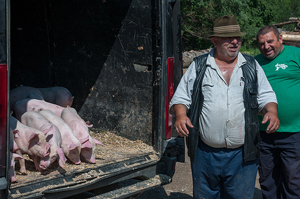While Chillie and Boo Radley are fictional characters, equivalent outcasts show up in real life. One such character figures prominently in John Irving’s memoir, Trying to Save Piggy Sneed. Up until he was seven years old, author John Irving lived with his grandmother on Front Street in Exeter, New Hampshire. Irving writes about being one of the children who teased and taunted the neighborhood garbage man, Piggy Sneed.

Source: Buchenland, Bukovina, farmer, farrow, Lens Nikon 16-85mm f-3.5-5.6G ED VR DX AF-S Nikkor, pig, piglet, Romania.jpg, globetrotter_rodrigo, Flickr
His name was Piggy Sneed. He smelled worse than any man I ever smelled—with the possible exception of a dead man I caught the scent of, once, in Istanbul. And you would have to be dead to look worse than Piggy Sneed looked to us children on Front Street. To begin with, he lived on a pig farm. He raised pigs, he slaughtered pigs; more importantly, he lived with his pigs--it was just a pig farm, there was no farmhouse, there was only the barn. There was a single stovepipe running into one of the stalls. That stall was heated by a wood stove for Piggy Sneed's comfort—and, we children imagined, his pigs (in the winter) would crowd around him for warmth. He certainly smelled that way.
Also he had absorbed, by the uniqueness of his retardation and by his proximity to his animal friends, certain piglike expressions and gestures. His face would jut in front of his body when he approached the garbage cans, as if he were rooting (hungrily) underground; he squinted his small, red eyes; his nose twitched with all the vigor of a snout; there were deep pink wrinkles on the back of his neck--and the pale bristles, which sprouted at random along his jawline, in no way resembled a beard. He was short, heavy, and strong--he heaved the garbage cans to his back, he hurled their contents into the wooden, slat-sided truck bed. In the truck, ever eager to receive the garbage, there were always a few pigs. Perhaps he took different pigs with him on different days; perhaps it was a treat for them--they didn't have to wait to eat the garbage until Piggy Sneed drove it home. He took only garbage-no paper, plastic, or metal trash--and it was all for his pigs. This was all he did; he had a very exclusive line of work. He was paid to pick up garbage, which he fed to his pigs. When he got hungry (we imagined), he ate a pig. "A whole pig, at once," we used to say on Front Street. But the piggiest thing about him was that he couldn't talk. His retardation either had deprived him of his human speech or had deprived him, earlier, of the ability to learn human speech. Piggy Sneed didn't talk. He grunted. He squealed. He oinked--that was his language; he learned it from his friends, as we learn ours.
We children, on Front Street, would sneak up on him when he was raining the garbage down on his pigs--we'd surprise him: from behind hedges, from under porches, from behind parked cars, from out of garages and cellar bulkheads. We'd leap out at him (we never got too close) and we'd squeal at him: "Piggy! Piggy! Piggy! Piggy! OINK! WEEEE!" And, like a pig-panicked, lurching at random, mindlessly startled (every time he was startled, as if he had no memory)--Piggy Sneed would squeal back at us as if we'd stuck him with the slaughtering knife; he'd bellow OINK! out at us as if he'd caught us trying to bleed him in his sleep.
I can't imitate his sound; it was awful, it made all us Front Street children scream and run and hide. When the terror passed, we couldn't wait for him to come again. He came twice a week. What a luxury!
Text-to-Text Connections

Source: Reading, Jonas Soderstrom, Flickr
John Irving’s description of the bizarre Piggy Sneed brings Boo Radley to mind. While the children in To Kill a Mockingbird fabricated a horrific monster and made up unbelievable stories about the reclusive Boo, Irving and his neighborhood friends didn’t need to use their imaginations. Piggy Sneed provided drama and excitement every time he picked up Irving’s grandmother’s garbage. While the two adults are not identical, they share some characteristics that provide insight into outcasts in general. For instance, the children in both literary works felt free to give the adults demeaning and disrespectful nicknames. Find the lines in the excerpt from “Trying to Save Piggy Sneed” that provide evidence of other similarities.
